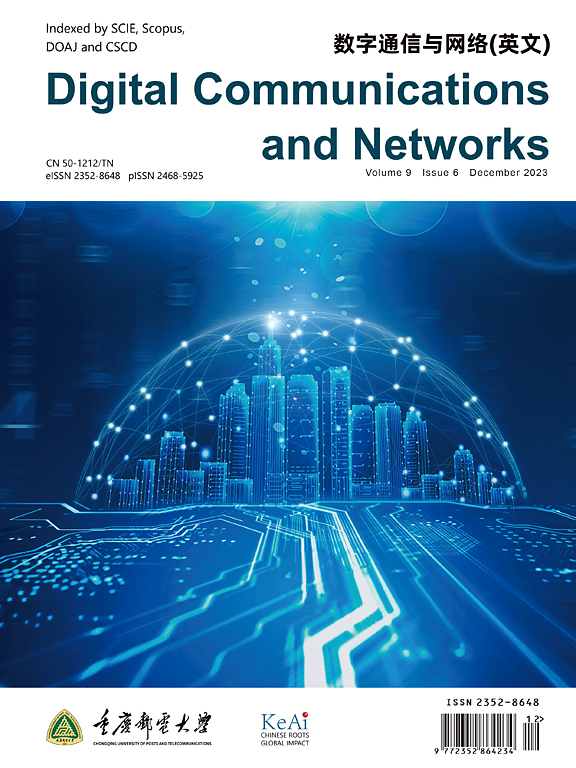Research on paging enhancements for 5G-A downlink transmission energy saving
IF 7.5
2区 计算机科学
Q1 TELECOMMUNICATIONS
引用次数: 0
Abstract
5G-Advanced (5G-A), an evolutionary iteration of 5G, effectively enhances 5G services. The increasing complexity in downlink services scenarios stresses the necessity for research into the integration of efficient communication with low-carbon solutions. Historically, there has been an emphasis on reliability and precision, at the expense of power consumption. Although energy-saving technologies like Idle mode-Discontinuous Reception (IDRX) and Paging Early Indication (PEI) have been introduced to reduce power consumption in UE, they have not been fully tailored to the paging characteristics of 5G-A downlink services. In this paper, we take full account of the impact of paging message density on energy saving measures and propose an enhanced paging technology, termed Predictive-PEI (PPEI), which is designed to reduce UE overhead while minimizing latency whenever possible. Towards this end, we design a dual threshold decision framework founded on machine learning, mainly involving two steps. We first use the LSTM-FNN neural network to forecast the arrival moment of upcoming paging messages based on past real information. Then, the output of the initial prediction is as the input of the next dual threshold decision algorithm, to determine the optimal moment for transmitting the PEI. The restrictive factors, encompass average delay threshold and cache capacity threshold, playing a role in decisions regarding paging message caching and decoding. Compared to the existing schemes, our PPEI scheme flexibly sends efficient PEI according to the actual paging characteristics by introducing machine learning, resulting in substantial power savings of up to 38.89% while concurrently ensuring effective latency control.
5G-A下行传输节能的寻呼增强技术研究
5G- advanced (5G- a)是5G的演进迭代,有效增强了5G业务。下行服务场景日益复杂,因此有必要研究如何将高效通信与低碳解决方案相结合。从历史上看,人们一直以功耗为代价,强调可靠性和精度。虽然已经引入了空闲模式不连续接收(IDRX)和寻呼早期指示(PEI)等节能技术来降低UE的功耗,但它们并没有完全适应5G-A下行链路服务的寻呼特性。在本文中,我们充分考虑了分页消息密度对节能措施的影响,并提出了一种增强的分页技术,称为Predictive-PEI (PPEI),该技术旨在减少UE开销,同时尽可能地减少延迟。为此,我们设计了一个基于机器学习的双阈值决策框架,主要涉及两个步骤。我们首先利用LSTM-FNN神经网络基于过去的真实信息预测即将到来的寻呼消息的到达时刻。然后,将初始预测的输出作为下一个双阈值决策算法的输入,以确定传输PEI的最优时刻。限制因素包括平均延迟阈值和缓存容量阈值,它们在有关分页消息缓存和解码的决策中发挥作用。与现有方案相比,我们的PEI方案通过引入机器学习,根据实际分页特征灵活地发送高效PEI,在保证有效延迟控制的同时,节省了高达38.89%的大量功耗。
本文章由计算机程序翻译,如有差异,请以英文原文为准。
求助全文
约1分钟内获得全文
求助全文
来源期刊

Digital Communications and Networks
Computer Science-Hardware and Architecture
CiteScore
12.80
自引率
5.10%
发文量
915
审稿时长
30 weeks
期刊介绍:
Digital Communications and Networks is a prestigious journal that emphasizes on communication systems and networks. We publish only top-notch original articles and authoritative reviews, which undergo rigorous peer-review. We are proud to announce that all our articles are fully Open Access and can be accessed on ScienceDirect. Our journal is recognized and indexed by eminent databases such as the Science Citation Index Expanded (SCIE) and Scopus.
In addition to regular articles, we may also consider exceptional conference papers that have been significantly expanded. Furthermore, we periodically release special issues that focus on specific aspects of the field.
In conclusion, Digital Communications and Networks is a leading journal that guarantees exceptional quality and accessibility for researchers and scholars in the field of communication systems and networks.
 求助内容:
求助内容: 应助结果提醒方式:
应助结果提醒方式:


